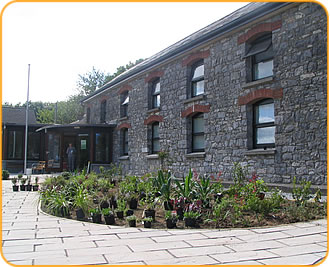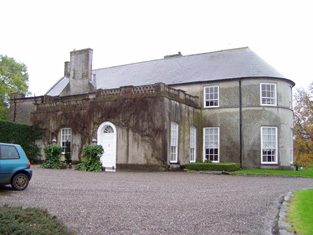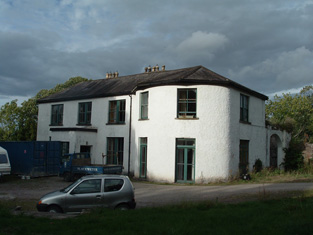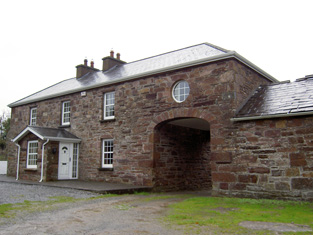Carrigacunna Castle
Houses within 5km of this house
Displaying 18 houses.
Houses within 5km of Carrigacunna Castle
Displaying 18 houses.
| House name | Description | |
|---|---|---|
| Clifford | This house was occupied by Richard Martin in 1814 and by Thomas Lloyd in 1837 and at the time of Griffith's Valuation, when he held the property from Edward Beatty. The buildings were valued at £26. Clifford passed by marriage to the Mansergh family of Grenane, county Tipperary and at the time of the sale in 1879 was inhabited by Captain C.S. Mansergh, who held it on a lease dated 1868. The representatives of E. Charles Mansergh of Clifford owned 511 acres in county Tipperary in the 1870s. In 1942 the Irish Tourist Association survey reported that it was the residence of the Walton family nd that the estate had been reduced to 40 acres. This house was recently renovated. |

|
| Carrig Park | This early 18th century house was the residence of William Causabon in 1744. By the 1770s it was the seat of a branch of the Franks family, who continued to reside there until the beginning of the 20th century. The house was held by William Hume Franks in fee at the time of Griffith's Valuation when the buildings were valued at £45 but the valuation was reduced to £35.10 shillings by 1906. The house was burnt in the early 1920s and later demolished. |

|
| Carrigoon | Occupied by Timothy Collins in the early 1850s and held from Joseph C. Nagle. The buildings were valued at £13. In 1942 the Irish Tourist Association survey noted its association with David Nagle who was MP for Mallow in 1689. The survey mentioned the survival at that time of the stables and coach house. A small ruined portion of this property remains, in an area where extensive quarrying has taken place. | |
| Hunting Hill | Hunting Hill, a single storey house, in the townland of Ballyhimock is marked on the first Ordnance Survey map. Home of the Dwyer family in the first half of the 19th century it was occupied by Mr William Dwyer in 1814 and by Thomas Dwyer at the time of Griffith's Valuation. Located on the Annesley estate it was valued at £15. Various tenants lived at Hunting Hill in the latter half of the 19th century until it was leased to Edward Vaughan, whose descendants continue to live here throughout the 20th century. A house is still extant at the site. | |
| Glenanore/Glananore | Part of this house appears to date from the early 18th century. It belonged to the Verling family, whose interest eventually became vested in the Johnson family. The Reverend Richard Purcell was the tenant in the latter part of the 18th century and Wilson refers to it as his seat in 1786. It was occupied in 1814 by Garret Nagle and by the early 1830s the Hoares were resident. At the time of Griffith's Valuation Mrs Mary Anne Hoare was the occupier, holding the property from Noble Johnson. The buildings were valued at £32. Mrs Hoare was the widow of Reverend Thomas Hoare who was a brother of Sir Joseph Wallis Hoare, 3rd Baronet. In 1942 the Irish Tourist Association Survey asserted that the front part had been constructed in the early nineteenth century but that other parts were much older. It was then the residence of E.J. Hoare and it was still occupied by members of the Hoare family in the 1950s but is now demolished. |

|
| Annakisha | The Nangles appear to have held Annakisha from the end of the 17th century and the house may possibly have dated from this time. Pierce Nagle was resident in 1814 and in 1837 and in the early 1850s held the property in fee. The buildings were valued at £22. Sold by Pierce Nagle to the Hamiltons of Castle Hamilton, county Cavan. Hajba writes that the house was derelict by the beginning of the 20th century and it does not appear on later maps. | |
| Johnsgrove | Originally a Glover family home, by the time of Griffith's Valuation it was occupied by Francis F.P. Holmes and held from Walter Nugent. The buildings were valued at £30. This house is still occupied. |

|
| Castlekevin | Originally a Roche stronghold which was granted to William Thornhill a Cromwellian soldier. It remained the seat of the Thornhill family until the mid 19th century. The old castle was incorporated into a castellated mansion in the 1830s. Lewis writes in 1837 that the ‘present extensive castellated mansion was rebuilt by Mr Thornhill after designs by Mr Flood, in the Elizabethan style’. Sold by the Thornhills in the mid 19th century to the Reeves family in whose possession it remained until the 1930s. Still extant and occupied. |

|
| Killuragh | Built by the Thornhills in the late 18th century and soon afterwards leased to the Linehan family. Cornelius Linihan was resident in 1837 and Ellen Linehan in the early 1850s. She held the property from Edward B. Thornhill, the buildings were valued at £20. A lithograph of this house is included in the sale rental of 1851 but there is not much similarity between it and the present building which is now known as The Glen. |

|
| Ballygriffin | Described by Smith in the mid 18th century as "a pretty seat of Mr David Nagle". This house was the birthplace of Nano Nagle. By 1814 Ballygriffin was occupied by William J. Boyce and in the early 1850s by Ellen Linehan who held the property from J.C. Nagle. The buildings were valued at £6. In 1942 the Irish Tourist Association Survey reported that the building was in ruins but it was restored in the late 20th century and is now known as the Nano Nagle Centre, preserving the heritage of the Presentation Nuns worldwide. |

|
| Kilcummer | This would appear to have been a Wilson residence from the late 18th century though Wilson, writing in 1786, refers to it as the seat of "Mr. Groves". . Hajba writes of earlier associations with the Oliver, Cole Bowen and Grove families. Henry Cole Bowen was resident in 1750. At the time of Griffith's Valuation William Wilson was the occupier. He held the property from Benjamin Grubbs and it was valued at £10. In the 1870s William Wilson of Kilcummer owned 182 acres in county Cork. This house is no longer extant. | |
| Castle Widenham [Blackwater Castle] | Originally a Roche stronghold, the castle was granted to the Widenhams in the mid 17th century. The castle was altered in both the 18th and 19th centuries. In the early 19th century it passed by marriage to the Brazier Creagh family and again by marriage to the Smyths. At the time of Griffith's Valuation the buildings were valued at £70 and held by Henry M. Smyth from Henry Leader. In 1894 it was the seat of Mrs. Smyth. In 1942 the Irish Tourist Association survey noted that it was still part of the Smyth family estate. Also known as Blackwater Castle, it is still extant. In 2022 it was offered for sale. |
![Photo of Castle Widenham [Blackwater Castle]](https://landedestates.ie/storage/img/orig/1571.jpg)
|
| Rockforest Lodge | This house was the residence of Pierse Creagh in 1837. At the time of Griffith's Valuation Henry O. Seavers occupied this house, valued at £24 and held by him in fee. This house is still inhabited. In 2010 it was offered for sale. see http://www.michaelhdaniels.com/index.cfm?fuseaction=propsearch |

|
| Rockforest | The seat of the Cotter family from the mid 18th century and occupied by them until the 20th century. Wilson, writing in 1786, describes it as "a most beautiful improvment, highly wooded, situated on the Blackwater, the seat of James Laurence Cotter". Occupied by Mrs J.R. Cotter, sister-in-law of the 3rd Baronet, in the mid 19th century when the buildings were valued at £18. By 1906 its value had risen to £38.15 shillings. Only half of the house now survives, the Irish Tourist Association Survey of 1942 noting that "the greater part of the building had been knocked down". For sale in 2012 through Savills. |

|
| Ballymacmoy | The Hennessys were settled at Ballymacmoy from the mid 18th century. In 1786 Wilson refers to "Ballymacboy" as the seat of Mr. Hennessy. A new house was built circa 1820s. By the time of Griffith's Valuation the Hennessy home was valued at £13.5 shillings and was held in fee by James Hennessy. He also owned a flour mill valued at £70 which he leased to Henry B. Foote. This house was still a Hennessy home in the 20th century and the house is still extant. |

|
| Monanimy Castle | In the mid 19th century William Barry occupied Monanimy Castle which was valued at £15.10 shilllings and held from George Bennett. Hajba writes that Barry restored the castle and that he was related to the Nagles who had originally owned the castle. The Barrys remained as residents of the castle until the 1940s when the castle was damaged by a fire. It has been restored and is now a family home. | |
| Rocksavage | This house was not built at the time of the first edition Ordnance Survey circa 1840. Built for John Craven Mansergh [in the 1850s] on land that formerly belonged to the Martin family. In 1942 the Irish Tourist Association Survey reported that Rocksavage was the residence of Dr. Foley. This house, situated close to the Awbeg River just south of Castletownroche, is still extant. | |
| Dromrahan | A mansion house valued at £20 is recorded at Dromrahan in 1906. Matthew H. Franks was the occupier. This house was built in the second half of the 19th century and is not recorded in Griffith's Valuation. A large complex of buildings at the site is labelled Dromrahan House on the 25-inch Ordnance Survey map of the 1890s. It is still extant and occupied. |

|

